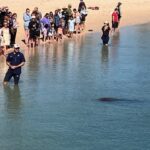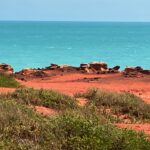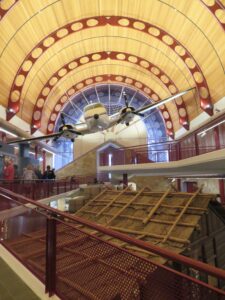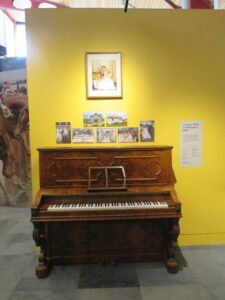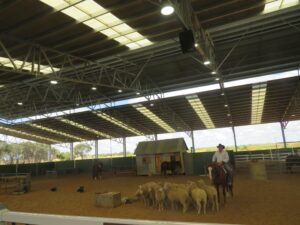Great Kidman Aussie Way
‘Let’s go on a trip!’ said John.
‘Where will we go?’ said Robert.
‘I know a great trip we can go on, let’s travel the Kidman Way,’ said Allan.
The three brothers were sitting in a pub dressed in shorts, singlets and thongs planning a trip to the outback. They had never been past Yass and wanted to continue to the Great Kidman Aussie Way and travel the Golden highway back home again.
The Kidman Way is a highway in the western region of New South Wales. It services the Murrumbidgee Irrigation Area and outback communities.
Their current home was a small weatherboard house with a Hills Hoist clothesline out the back. John liked to swing on it. The house had cow horns on the wall. Many books on gold, crystal, and opals to read.
John had a precious gem collection of rose quartz, smoky quartz, and a few other precious gemstones. Allan liked gold and everything about it. He had shares in many of the mines, everything fascinated him about the precious metal. Robert loved opals and collected many types, but the black opal was his great desire to see.
They all worked in the coal mines and were tough Aussie men.
They wore boots and cowboy hats. Loved riding horses and chopping wood.
Allan had golden hair that changed in the shining sun. He was tall and thin. He was as sharp as a tack and never missed a beat. Loud nature and everyone knew he was in the room. He loved country and western music and reading.
Robert was tall, dark, and handsome, medium build and always disagreeing with his brothers. He loved drinking, smoking, and having a great old time.
John was blonde, short, and cute. Slightly plump and very quiet. He loved to please everyone and always thought of others first.
The day had arrived. The three brothers left in the Holden black Ute. They were all going to take turns to drive the many kilometres along the way. First stop Gundagai just before the Kidman Way.
Let the fun begin. All the men stayed at the local pub. Shared a few beers at the Royal pub and a snitty for dinner. A few laughs and plans along the way. Met a few local girls to enjoy the night. Learnt about the local history and planned a short trip to Tumut.
Tumut is in the foothills of the Snowy Mountains. As they pull to the pub they could see a big red coach, then a sign no beer on Tuesdays and opening hours 10am maybe, 12 noon bistros sometimes, 5pm late. I see a cider shop that’s open, let try it. Be careful it has a kick. Allan said did you know Tumut make straw brooms, horse whips and sheep skin mats. Now let’s check out the All-Saints church, courthouse, bank, Montreal Theatre, and lookout. I hear the lookout has specular views.
After the morning sight-seeing John said, ‘Let’s go back to Gundagai for happy hour?’
‘Sounds great to me,’ said Allan and Robert. A steak and early night ready for the long drive tomorrow they all agreed.
The start of the Great Kidman Aussie Way is Jerilderie on the Newell Highway. Famous for the bushranger Ned Kelly and the robbery that took place in Powell Street. There is a museum called Willows Homestead, a blacksmith shop, Post Office, a printing office and a beautiful lake and park nearby. A cemetery where many associated with the Kelly Gang are buried.
The three men walked and talked about the famous Kelly Gang. They imagined what times were like back then. There is a huge tank at the Luke Park they were looking at when a local passed by. He was riding a three-wheel bike he designed. Garry told the men that this was specially made for his retired Kelpie named Blacky. His job for sixteen years was rounding up sheep. Garry was a shearer now retired as well. His was the only way Blacky could go for a long walk, as age had caught up with him.
Next Allan, Robert and John stopped off at Griffith. In the main street there is a memorial to Pioneer Woman. A beautiful park across the road from the best Italian food. The pasta is out of this world. Those Italians sure can cook. Next the men tried the tasty cannoli vanilla and chocolate. ‘Let’s go for a wine tasting,’ Robert said. ‘Sure, we are in wine country,’ said the others. They also went to see the remarkable cemetery, museum, cave, and lookout. Now off to taste some great whites and red wines.
Off to Merriwagga, with incredible silo art. Let’s have a beer at the Black Stump Hotel. The staff told the men about a woman in 1886 who was cooking dinner and her dress caught fire and she was burnt to death. When her husband found her, she looked like a black stump. This is how the hotel was named or what most believed.
Hillston is next stop on the Lachlan River. Lots of red soil, we need to be careful as this is the stuff your car will get bogged in when it’s wet. The black soil is worst, your car will sink and never to be seen again. Stay on the tar to be safe guys. Hillston has some steel emus, out back art and a great motel. It’s close to clear quartz country.
John was so excited we are off to Mount Hope for clear quartz crystals. There is a pub that packs a mean burger, we can eat after the digging. Quartz crystals are famous for this area. Crystal means clear ice. It has healing attributes and brings the body into balance.
It was not long before the men had arrived. They took out their gear and started digging. Wow! Robert found the first piece and next Allan. They were small pieces of quartz crystal but still worthy of their efforts. The three men dug for an hour or so and mentioned they wanted to go to the pub. John was determined to find something special and wanted to be there all day. They all agreed another hour then they were off. John, Robert, and Allan found many small pieces in the next hour but nothing special. It’s time to move on to the pub for a burger and beer.
They were all in the ute and about to leave when John said, ‘WAIT! We have not checked under the Ute for crystals.’ Both brothers broke out in a yell, ‘no! we want to go to the pub.’ Allan and Robert could see the frustration and anger on John’s face. ‘Ok just look under the Ute but John, only you go, and we will wait in the Ute for you.’
Out John went again with all this gear and started digging furiously. A few minutes went buy the two men were saying what a waste of our time to each other, when there was a almighty roar. YES, ok my goodness I found it. It’s big, I need your help. Out the men jump to look. Wow you have found it, let’s get our gear. They dug, pulled, and chipped. Sweat poring off all of them. Lucky, we have a ute. Finally, out it came. It was huge. They all lifted it out and put it into the ute. Let’s tie it down and cover it up. Now off to the pub, do not mention our find. Next, they all enjoy a cold beer and burger and wondered what the crystal was worth.
Allan piped up and said, ‘Cobar for gold.’ Off they went on their travels. First, let’s look at gold mine. After a hundred kilometres they see the turn off in the road and pulled up. Look at that rock, a fine example. Let’s go to the viewing platform, wow they are operating, and you can see the men at work. The workers are mining for gold.
There is an open cut mine near Cobar we can see. Yes, Fort Bourke Hill Lookout. Let’s go. It’s not far away. As they pull up the ute an incredible masterpiece awaits them. Allan cannot hold himself back. The sheer size, craft, picture of this mine. Wow this has made my day, I could look at this forever. Look at that tiny truck down there. See the masterpiece the miner has carved into the rock.
Time to go to the town. It’s full of pubs, cafes, and the unusual sights. As they arrive a
B-double full of hay pulls up. Cobar is the outback, full of sheep, cattle, and goat country.
All board to the end of the Kidman Way at Bourke. We are staying in a Ranch, yippee! There is a gallery to see, and we can cruise up the Darling River on the old boat. As they arrived, they could see how high the floods were. The cruise took an hour and there were many beautiful sights to see. Its time to book into our ranch for the night. The men arrived and discovered a camp kitchen, pool, and barbie. I will go to town and pick up some meat, supplies, and beer of course for you all,’ said Robert.
Now we are in the real out back and off to Brewarrina and Walgett. Let’s leave at the crack of dawn tomorrow. We will end up at Lightning Ridge by night. There is a great club where all the miners eat. They have a great roast I hear.
On the way to Brewarrina there were many letter boxes in a row. Kangaroos are everywhere, both dead and alive. The grass is so high you can hardly see them. Now emus, sheep, and goats. ‘Oh no,’ called John, ‘a huge wild pig on the road up ahead’. Brewarrina and Walgett have many of our First Nation people living there. Some working on farms and very friendly. Beautiful windmills, green pastures, full dams, and isolated paddocks are in the distance. Plenty of red dirt for the Ute to get stuck in. It’s the black dirt we can really sink in so be careful. So many semis, B-doubles, and triples on the road.
Let’s travel to Lightning Ridge now, look up ahead at those amazing volcanic mountains.
It’s raining very heavy, and I hope the river has not cut the road. We were told it never rains in the Ridge. Off to Lightning Ridge they go, for the rare black opals. So many Road Trains travelling full of cars along the road. The rain is creating a mirage effect up ahead.
They find a cabin for a few nights. ‘Let’s go to the club for dinner and a beer,’ said Robert. All agree and on the way a storm hits. We were told it never rains here,’ said Allan. They arrive at the club and it’s raining so hard the roads in a blink of an eye are flooding. The thunder is so loud it sounds like the mines are being blown up. No, it is lightning. Now at the club carpark. The road beside it is flooding and our Ute could be filled with water when we get back. ‘Let’s eat fast, have a quick beer, and get back to the cabin.’
The storm is getting worst, it’s time to go. As they drive out of the town many roads are flooded. They cannot see what is in front from all the torrential rain. There is deep water up ahead and plenty of red clay road. The Ute swerves to miss another car and is now stuck in the mud. Out they hop, two pushing and one driving. Red clay and mud everywhere. No luck. We will have to leave it until tomorrow. I see the entrance to the tourist park. The bridge is ok, so they made it back to the cabin all soaking wet. Rain, thunder, lightning is getting worst, water is rising to the cabin. Oh no, we could be floating in the night.
Morning breaks and the sun comes out, the water level drops, and all is ok again. The others wake up, let’s try and get the Ute now. After many attempts the Ute moves onto the tar. Now its dirty. It’s time for the Car Door Tour so let’s have some fun. I have checked and the Green Door Tour is closed as its flooded. Red, Yellow, and Blue Car Door Tours are ok. It will be a rip-roaring mud bath today. Tomorrow let’s see the black opal and the carvings.
Next Coonabarabran. Let’s go via Gunnedah.
Many stone churches, beautiful parks, museums, and the Pensioner Lookout. Bridges to cross, goat farms, and mountains and hills to see along the way.
Coonabarabran for the observatory and crystal museum. They have seventeen telescopes, and we can see inside one. The crystal museum is enormous one of the biggest in Australia. The Warrumbungle’s is another amazing sight to see beautiful rock formations.
Time to head home. What’s that up ahead?’ said Robert. ‘Road works!’ said John, a D9 travelling to the mines. It’s going to be a slow trip.’ Oh no they are stopping the cars for an hour to build the road. Wow just what we need guys. I guess we cannot do very much, just wait in line.
OMG look up ahead, a streaker with a mullet. He’s running stark naked along the road. Oh no. He jumped on the D9. Loud sounds, Police chasing him. Now he’s running at the side of the road. Where is he now? He’s run in the black soil. I cannot see him, he disappeared. He must be under the soil. I see his mullet. Let’s help him.
All guys are now out of the car chasing the streaker. The Police spot him, now they are chasing him as well. Oh no, we are all sinking in the black soil. Now the Police are in the black soil. HELP US. Road workers have come to rescue us all. Quick get a rope, throw it to them. Tie it around their waists. We cannot pull them out as the black soil is stuck to them and they are too heavy.
Get the D9, it will pull them out. The road workers tied the ropes to the machine and now pulling and pulling out they come. The streaker keeps running, and the three guys think it a great yarn to tell their mates. The Police are not impressed, the report they need to file no inspector will believe and they will be the talk of the town.
Next the local newspaper is here to interview and tell the story.
Let’s stay another day, it will be a great night at the local pub. Sure let’s all stay, then is off home along the Golden Highway.

